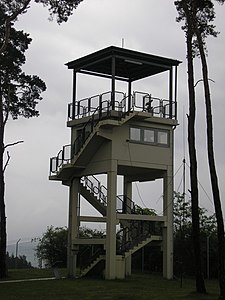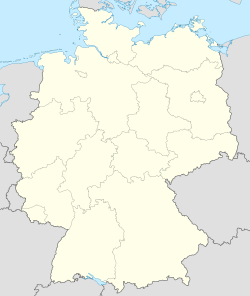| Observation Post Alpha | |
|---|---|
| Part of Inner German border | |
| Between Rasdorf, Hesse and Geisa, Thuringia in Germany. | |
 NATO Observation Post Alpha, watchtower. | |
| Site information | |
| Owner | Point Alpha Stiftung |
| Open to the public | Yes |
| Site history | |
| In use | late 1960s to 1991 |
Observation Post Alpha, OP Alpha or Point Alpha was a Cold War observation post between Rasdorf, Hesse, in what was then West Germany and Geisa, Thuringia, then part of East Germany. The post overlooked part of the "Fulda Gap", which would have been a prime invasion route for Warsaw Pact forces had the Cold War erupted into actual warfare. It was abandoned by the military in 1991. Today, the "Point Alpha" memorial commemorates its forty-year existence, and was dedicated to keep it and a section of inner German border as reminders of the division of Germany and the confrontation between NATO and Warsaw Pact in the Cold War.
Operations[]

Reconstructed border fence and NATO observation tower, near Rasdorf, Germany.
Observation Post Alpha was one of four U.S. Army observation posts along the Hessian part of the inner German border. OP Alpha was manned by the 1st Squadron, 14th Armored Cavalry Regiment stationed in Fulda and re-flagged as the 11th Armored Cavalry Regiment in 1972. To the north were other observation points, OP Romeo, OP India, and OP Oscar, manned by the 3rd Squadron, stationed in Bad Hersfeld. The 2nd Squadron was stationed in Bad Kissingen, and guarded the border at OP Tennessee (OP Sierra) to the south. Jeeps and helicopters were used to patrol the areas in between, with occasional increased border activity with armored vehicles. OP Alpha fulfilled NATO defence reconnaissance south of the East German crossroads town of Vacha, regarding its view of Geisa, then the western-most town of the Eastern Bloc; the Warsaw Pact had counterpart observation posts on their side of the border.

East German border fortification near OP Alpha
The OP overlooked part of the "Fulda Gap" from atop a 411-meter hill, lying in the centre of that section of the NATO defence line. The "Fulda Gap" was considered a strategic location by NATO for a Warsaw Pact invasion. The name OP Alpha dates to its being the first such point; geography also allowed monitoring Communist radio traffic. The use of the AN/PPS-5 ground surveillance radar set in the observation tower allowed 24-hour monitoring of activity on the roads leading into Geisa. At the first sign of an invasion the OP Alpha crew would have withdrawn, as the actual planned battlefields to meet a Warsaw Pact invasion lay a couple of kilometers to the west. Due to its exposed position, the OP was also referred to as "the hottest spot of the cold war".[1]
History[]

East German watchtower adjacent to OP Alpha
- 1962 A border incident occurred near the future location of OP Alpha. An East German border guard captain fired at a group of West German border policemen, and in turn was shot and killed by one of the West German border policemen.[2]
- 1965 Responsibility for border surveillance in the area was turned over from the German BGS to the U.S. Army. In the years following, construction of observation structures was accomplished.
- 1968 The first observation tower made of wood was established, replaced in 1982 with a steel tower and again in 1985 with the current concrete structure. It also became the base of the U.S. 14th Armored Cavalry Regiment.
- 1972 The U.S. 11th Armored Cavalry Regiment ("Blackhorse Regiment") assumed the post. Under normal circumstances, approximately 40 soldiers were stationed for four weeks at OP Alpha. A typical manning of a border OP was one platoon of armored cavalry, with up to 10 armored vehicles. In crisis situations the garrison strength rose to 200 men.
- 1991 The U.S. Army withdrew from the post following German reunification.
Following reunification, the post was supposed to be removed along with the other remaining observation posts at the inner German border. However, a citizens' initiative was formed to prevent its destruction. By the end of 1994, the camp was used as an accommodation for asylum-seekers and in 1995 it was placed under historical protection. That same year the border museum association Rhön Point Alpha was created and began the construction of today's memorial with the support of the Thuringian state government.
Today[]
Today, "Point Alpha" is the name of a museum on the road between Geisa (Thuringia) and Rasdorf village (Hesse). The former OP now houses an exhibition on the presence of US forces which includes several military vehicles. The museum complex covers not only the NATO observation post on the Hessian side, but also a strip of the original border protection systems of East Germany, including a visitors' center on the Thuringian side (Haus auf der Grenze), which features an exhibit on the inner German border.[3] In 2011, the memorial was awarded the European Heritage Label.[4]
Since 2005, there has been a "Point-Alpha-Preis", named after the installation. It is awarded to people who have made a positive contribution to German or European unity. In 2013, the price went to former President of Poland, Lech Walesa. Prior recipients were Helmut Kohl, George Bush and Mikhail Gorbachev (in 2005), Václav Havel (in 2008) and the citizens' movement in the GDR (in 2009).[5]
References[]
- ↑ "Gedenkstätte "Point Alpha" (German)". Gemeinde Rasdorf. http://www.rasdorf.de/tourismus/sehenswuerdigkeiten/gedenkstaette-point-alpha.html. Retrieved 29 April 2013.
- ↑ Deutscher Bundestag, 14. Wahlperiode, Drucksache, 14/7234, 26. 10. 2001, Schriftliche Fragen mit den in der Woche vom 22. Oktober 2001, eingegangenen Antworten der Bundesregierung, Antwort des Parlamentarischen Staatssekretärs Fritz Rudolf Körper, vom 19. Oktober 2001 (Written questions of the 14th Voting Period of the German Federal Bundestag, answer of the Parliamentary State Secretary Fritz Rudolf Körper on October 19, 2001). On August 14, 1962, Oberjäger T.P. of the BGS shot and killed DDR Army Hauptmann R.A. when he observed R.A. preparing to fire again at a BGS officer. The border incident occurred at Setzelbach, Hesse. This document can be found on the web at [1]. An article from the Frankfurter Rundschau on August 9, 2002, further reports on this amazing story, identifying the BGS trooper as Hans Plüschke and the DDR border officer as Rudi Arnstadt. Plüschke's 1962 shot struck Arnstadt in the right eye, killing him instantly. On March 15, 1998, Hans Plüschke, who had become a taxi driver, was found murdered on Bundesstrasse 84 between Rasdorf and Hünfeld, shot in the right eye. German authorities considered the possibility that this was a 36-year-delayed act of revenge by former DDR agents. The article can be viewed on the web at: http://www.stasiopfer.de/component/option,com_simpleboard/Itemid,/func,view/id,1029014251/catid,4/
- ↑ Kania, Martin (20 July 2009). "Gedenkstätte Point Alpha - Der heißeste Ort des Kalten Krieges (German)". HR-online. http://www.hr-online.de/website/specials/mauerfall/index.jsp?rubrik=47824&key=standard_document_37571888. Retrieved 29 April 2013.
- ↑ "Gedenkstätte Point Alpha (German)". Thüringen Tourismus. http://www.thueringen-tourismus.de/urlaub-hotel-reisen/gedenkstaette-point-alpha-104153.html. Retrieved 29 April 2013.
- ↑ "Lech Walesa mit Point-Alpha-Preis ausgezeichnet(German)". Mdr. 16 June 2013. http://www.mdr.de/thueringen/lech-walesa-erhaelt-point-alpha-preis100.html. Retrieved 26 June 2013.
External links[]
| Wikimedia Commons has media related to Point Alpha. |
Notes[]
The original article can be found at Observation Post Alpha and the edit history here.
